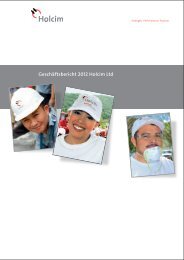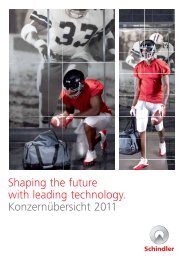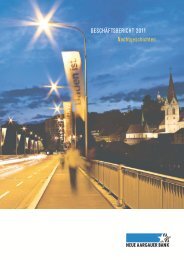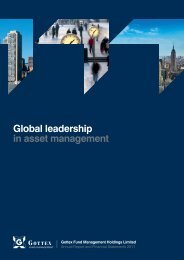Transocean Proxy Statement and 2010 Annual Report
Transocean Proxy Statement and 2010 Annual Report
Transocean Proxy Statement and 2010 Annual Report
You also want an ePaper? Increase the reach of your titles
YUMPU automatically turns print PDFs into web optimized ePapers that Google loves.
TRANSOCEAN LTD. AND SUBSIDIARIES<br />
NOTES TO CONSOLIDATED FINANCIAL STATEMENTS — Continued<br />
GlobalSantaFe were rejected by the Court in Avoyelles Parish, <strong>and</strong> the lawsuit against the other defendant went to trial on February 19,<br />
2007. This lawsuit was resolved at trial with a settlement by the codefendant that included a $20 million payment <strong>and</strong> certain cleanup<br />
activities to be conducted by the codefendant. The codefendant further claimed to receive a right to continue to pursue the original<br />
plaintiff’s claims.<br />
The codefendant sought to dismiss the bankruptcies. In addition, the codefendant filed proofs of claim against both our<br />
subsidiary <strong>and</strong> its parent with regard to its claims arising out of the settlement of the lawsuit. On February 15, 2008, the Bankruptcy Court<br />
denied the codefendant’s request to dismiss the bankruptcy case but modified the automatic stay to allow the codefendant to proceed on<br />
its claims against the debtors, our subsidiary <strong>and</strong> its parent, <strong>and</strong> their insurance companies. The codefendant subsequently filed suit<br />
against the debtors <strong>and</strong> certain of its insurers in the Court of Avoyelles Parish to determine their liability for the settlement. The denial of<br />
the motion to dismiss the bankruptcies was appealed. On appeal the bankruptcy cases were ordered to be dismissed, <strong>and</strong> the<br />
bankruptcies were dismissed on June 14, <strong>2010</strong>.<br />
On March 10, <strong>2010</strong>, GlobalSantaFe <strong>and</strong> the two subsidiaries filed a declaratory judgment action in State District Court in<br />
Houston, Texas against the codefendant <strong>and</strong> the debtors seeking a declaration that GlobalSantaFe <strong>and</strong> the two subsidiaries had no liability<br />
under legal theories advanced by the codefendant. This action is currently stayed.<br />
On March 11, <strong>2010</strong>, the codefendant filed a motion for leave to amend the pending litigation in Avoyelles Parish to add<br />
GlobalSantaFe, <strong>Transocean</strong> Worldwide Inc., its successor <strong>and</strong> our wholly owned subsidiary, <strong>and</strong> one of the subsidiaries as well as various<br />
additional insurers. Leave to amend was granted <strong>and</strong> the amended petition was filed. An extension to respond for all purposes was<br />
agreed until April 28, <strong>2010</strong> for the debtors, GlobalSantaFe, <strong>Transocean</strong> Worldwide Inc. <strong>and</strong> the subsidiary. On April 28, <strong>2010</strong>,<br />
GlobalSantaFe <strong>and</strong> its two subsidiaries filed various exceptions seeking dismissal of the Avoyelles Parish lawsuit, which have been<br />
denied. Subsequent to denial supervisory writs were filed with the Third Circuit Court of Appeals for the State of Louisiana.<br />
On December 15, <strong>2010</strong>, as permitted under the existing Case Management Order, GlobalSantaFe <strong>and</strong> various subsidiaries<br />
served third-party dem<strong>and</strong>s joining various insurers in the Avoyelles Parish lawsuit seeking insurance coverage for the claims brought<br />
against GlobalSantaFe <strong>and</strong> various subsidiaries.<br />
We believe that these legal theories should not be applied against GlobalSantaFe or <strong>Transocean</strong> Worldwide Inc. Our subsidiary,<br />
its parent <strong>and</strong> GlobalSantaFe intend to continue to vigorously defend against any action taken in an attempt to impose liability against them<br />
under the theories discussed above or otherwise <strong>and</strong> believe they have good <strong>and</strong> valid defenses thereto. We do not believe that these<br />
claims will have a material impact on our consolidated statement of financial position, results of operations or cash flows.<br />
Retained risk<br />
Our hull <strong>and</strong> machinery <strong>and</strong> excess liability insurance program consists of commercial market <strong>and</strong> captive insurance policies<br />
primarily with 12-month <strong>and</strong> 11-month policy periods beginning on May 1, <strong>2010</strong> <strong>and</strong> June 1, <strong>2010</strong>, respectively.<br />
Under the hull <strong>and</strong> machinery program, we generally maintain a $125 million per occurrence deductible, limited to a maximum of<br />
$250 million per policy period. Subject to the same shared deductible, we also have coverage for costs incurred to mitigate damage to a<br />
rig up to an amount equal to 25 percent of a rig’s insured value. Also subject to the same shared deductible, we have coverage for wreck<br />
removal for an amount up to 25 percent of a rig’s insured value, with any excess generally covered to the extent of our excess liability<br />
coverage described below. However, the shared deductible is $0 in the event of a total loss or a constructive total loss of a drilling unit.<br />
We carry $950 million of commercial market excess liability coverage, exclusive of deductibles <strong>and</strong> self-insured retention, noted<br />
below, which generally covers offshore risks such as personal injury, third-party property claims, <strong>and</strong> third-party non-crew claims, including<br />
wreck removal <strong>and</strong> pollution. Our excess liability coverage has separate (1) $10 million per occurrence deductibles on crew personal injury<br />
liability <strong>and</strong> on collision liability claims <strong>and</strong> (2) a separate $5 million per occurrence deductible on other third-party non-crew claims. These<br />
types of excess liability coverages are subject to an additional aggregate self-insured retention of $50 million that is applied to any<br />
occurrence in excess of the per occurrence deductible until the $50 million is exhausted. We generally retain the risk for any liability losses<br />
in excess of $1.0 billion.<br />
We also carry $100 million of additional insurance that generally covers expenses that would otherwise be assumed by the well<br />
owner, such as costs to control the well, redrill expenses <strong>and</strong> pollution from the well. This additional insurance provides coverage for such<br />
expenses in circumstances in which we have legal or contractual liability arising from our gross negligence or willful misconduct. As of<br />
December 31, <strong>2010</strong>, the insured value of our drilling rig fleet was approximately $38.5 billion in the aggregate, excluding rigs under<br />
construction.<br />
We have elected to self-insure operators extra expense coverage for ADTI <strong>and</strong> CMI. This coverage provides protection against<br />
expenses related to well control, pollution <strong>and</strong> redrill liability associated with blowouts. ADTI’s customers assume, <strong>and</strong> indemnify ADTI for,<br />
liability associated with blowouts in excess of a contractually agreed amount, generally $50 million.<br />
We generally do not have commercial market insurance coverage for physical damage losses, including liability for wreck<br />
removal expenses, to our fleet caused by named windstorms in the U.S. Gulf of Mexico <strong>and</strong> war perils worldwide. Except with respect to<br />
Dhirubhai Deepwater KG1 <strong>and</strong> Dhirubhai Deepwater KG2, we generally do not carry insurance for loss of revenue unless contractually<br />
required.<br />
AR-108

















